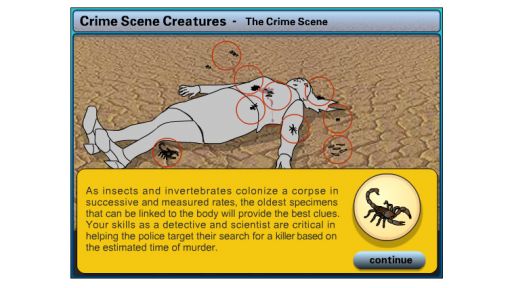Through the science of forensic entomology, the study of insects associated with a corpse, we learn that cadaverous critters can tell us a great deal about a crime.
As a body decomposes, certain insects and invertebrates colonize it in a sequential and measured rate. Dr. Gail Anderson, a forensic entomologist at Simon Fraser University in Vancouver, Canada, suggests that after three days, insect evidence is often the most accurate and sometimes the only method of estimating the elapsed time since death. Entomological evidence may also help determine how a person has died, or if a body has been moved or disturbed postmortem. The following case illustrates how the life cycle of a fly helped police solve a murder.
Case 1: Insect Informants
Through the science of forensic entomology, the study of insects associated with a corpse, we learn that cadaverous critters can tell us a great deal about a crime.
As a body decomposes, certain insects and invertebrates colonize it in a sequential and measured rate. Dr. Gail Anderson, a forensic entomologist at Simon Fraser University in Vancouver, Canada, suggests that after three days, insect evidence is often the most accurate and sometimes the only method of estimating the elapsed time since death. Entomological evidence may also help determine how a person has died, or if a body has been moved or disturbed postmortem. The following case illustrates how the life cycle of a fly helped police solve a murder.
The Case:
On a mid-November afternoon, police were called to investigate a foul-smelling odor emanating from a single-family home in the southeastern United States. It did not take long for the investigating officers to discover a shallow grave in the dirt basement of the house, which contained the badly decomposed body of a young female.
It was immediately apparent that the victim had died of a single bullet wound to the head inflicted by a small caliber rifle. A scrupulous examination of the corpse and excavation of the soil in and around the grave site by a forensic entomologist working with police revealed the presence of numerous larvae and pupae of two different fly species.
The specimens were collected from the scene and brought back to the laboratory to be reared. Supplemental information, including weather data and soil temperature, was also analyzed in order to determine the principal climatic conditions at the death site. Based on the developmental biology of both species of flies in that environment, the forensic entomologist estimated that the specimens associated with the body the longest were in their fourth stage of development. It was estimated that the victim had died approximately 28 days prior to the date her body was discovered.
This specific information allowed the authorities to target their investigation in and around the estimated time of death. Within a short time, they identified a female suspect who eventually confessed to having killed the victim precisely 28 days prior to the time the body was found. She further admitted to attempting to bury the victim in a shallow grave in the basement of the house after committing the homicide.
Calculating the developmental rate of the flies provided investigators with the only scientifically reliable method of estimating the time of the victim’s death and subsequently led to the arrest and conviction of the killer.
Case 2: A Grain of Truth
Pollen can certainly be irritating to those who suffer from allergies. But when incorporated into forensics, it not only irritates criminals but also can implicate them. Forensic palynology is the science of analyzing pollen and spores to help solve cases. Microscopic pollen grains from plants of a certain area are assembled in ratios to one another that are unique to that area. When compared with pollen samples from a suspect’s clothing, shoes, or vehicle, these “pollen prints” can point criminal investigators to a specific geographical location, prove or destroy alibis, and link a suspect to the scene of a crime.
Dr. Lynne Milne, a professor at the University of Western Australia in Crawley, is a forensic palynologist who used pollen and spores to help the police catch a killer in Queensland, Australia.
The Case:
In 1996, a young mother of two was discovered brutally murdered in a town called Noosa Heads, on the Queensland coast. Her body was dumped in a park among flowering wattle trees, native to Australia. The victim’s car turned up outside a man’s home in the nearby town of Gympie, inland from Noosa. Flower petals and plant debris littered the car’s interior. When police questioned the owner of the house, he outright denied having recently been in Noosa or driving the victim’s car. He did admit that the previous day he had walked on a path in Gympie where wattle trees were common. Though the police had their suspicions about the man, they had no hard evidence to tie him to the crime.
The police turned to Dr. Milne in the hope that she would shed some light on the case with regard to the plant matter. She observed that the wattle trees in Noosa are of a different species than those in Gympie and generally flower at a different time. She analyzed pollen samples from the two species at each location and identified their “pollen print.” She then examined pollen from the flowers that were found in and on the victim’s car, as well as samples vacuumed up from the car’s upholstery and lifted from the suspect’s clothing.
Dr. Milne’s analysis revealed that all of the flowers were indeed from Noosa, not Gympie, and that most of the pollen in the car and on the suspect’s clothing was also from Noosa — and a perfect match. This evidence was used to link the suspect to the scene of the crime. He was arrested and brought to trial, where he was convicted of the murder and sentenced to life imprisonment.
Case 3: Wooden Witnesses
The structure and physical nuances of wood can be as distinctive as a fingerprint and just as useful in solving a crime. Forensic wood anatomists are able to glean important clues on both macro- and microscopic levels — from matching growth patterns in large pieces of lumber to analyzing the physical characteristics of a splinter-sized fragment.
The first and perhaps most famous case in which wood anatomy was used in the court system to help solve a crime was the Lindbergh baby kidnapping.
The Case:
In the early morning hours of March 2, 1932, Charles Jr., the 20-month-old son of aviator Charles A. Lindbergh and heiress Anne Morrow, was snatched from his crib in his second-floor nursery. A broken handmade ladder was left at the scene. Several weeks after the kidnapping, Arthur Koehler, a wood anatomist at the Forest Products Lab in Madison, Wisconsin, was asked by the FBI to identify some splinters from the ladder. Koehler requested that he be allowed to examine the entire ladder, as it might provide him with key information regarding the crime. His request was granted 10 months later.
Upon closely examining the ladder parts, he noted a set of square holes in one rail that did not correspond to the ladder’s construction. He also discovered nicks left by tools including a hand saw, a chisel, and a hand plane, and the distinctive marks of a machine planer with a flawed blade. Koehler set out to find the mill that had manufactured the boards with the unique machine planer marks. After six months of visiting various mills in the area, he finally found a match — but all his hard work seemed to prove fruitless when he discovered that the mill held no records of past customers.
In September 1934, the police arrested Bruno Hauptmann as a suspect in the case when he tried to spend some of the marked ransom money. A search of his home turned up two hand saws that fit exactly the scratch marks left on the ladder, a hand plane that matched the marks on the ladder rungs, and nails identical to those in the ladder. Perhaps the most incriminating piece of evidence was a missing floorboard in Hauptmann’s house. It became obvious that one of the rails of the ladder was fashioned from it. Not only did the nail holes of the remaining floorboards match the misfit holes of the rail but also, Koehler showed through the comparative anatomy of the wood, the growth rings and grain pattern from the rail perfectly matched the wood from the remaining floorboards.
To the end, Hauptmann insisted he was innocent. He proclaimed proudly that he was a carpenter and if he had made the ladder, it certainly wouldn’t have broken. Nonetheless, he was convicted and sentenced to death.









